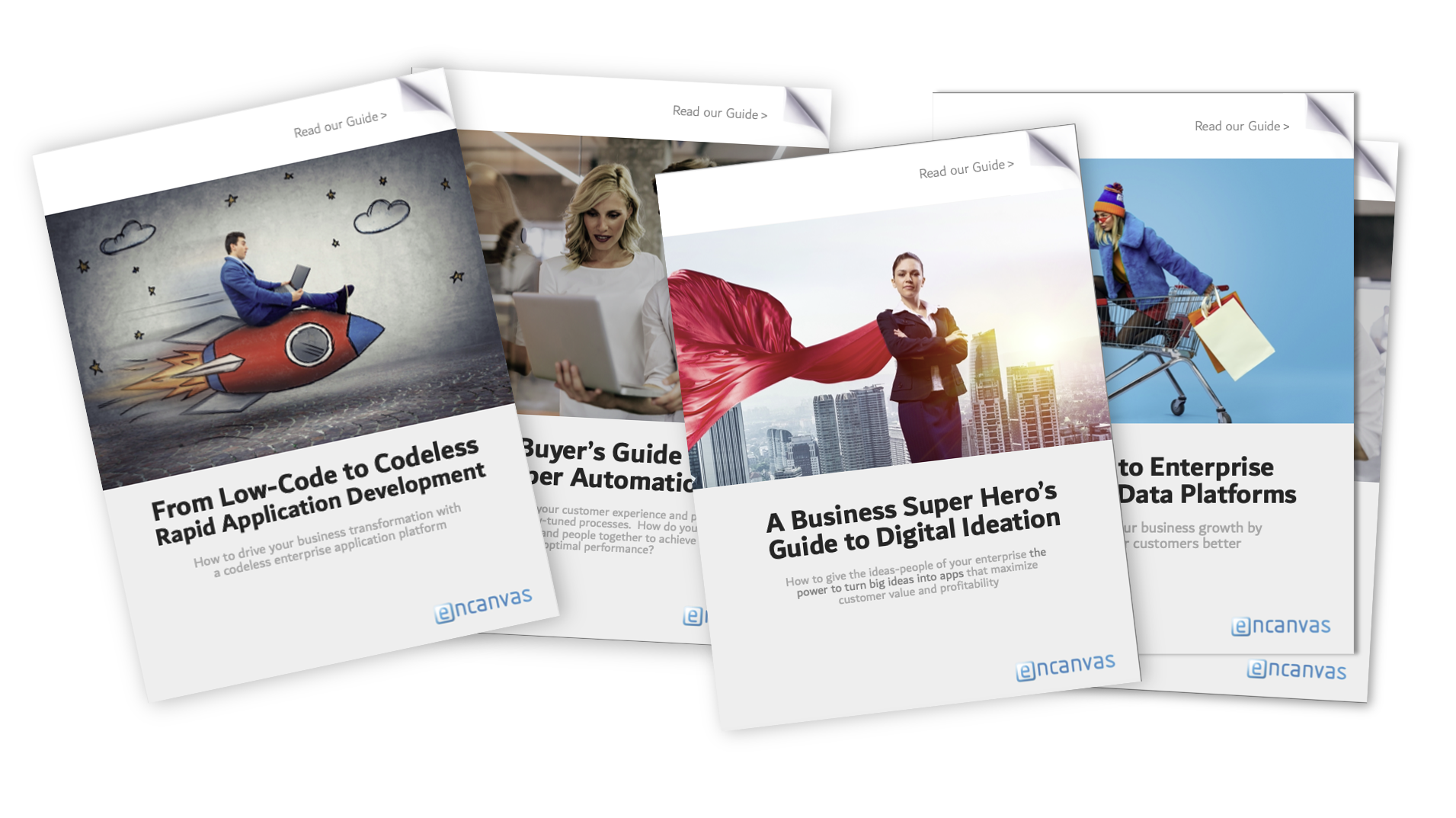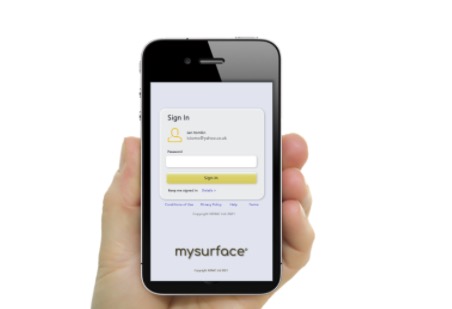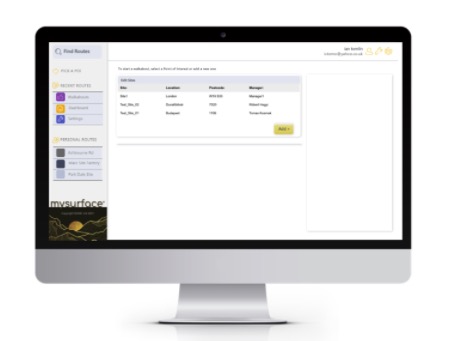EXPERIENCE ENCANVAS IN 60-MINUTES!
We're always happy to walk you through Encanvas no matter where you are in the world.
Data Integration is a term used to describe a collection of methods, tools and technologies used to connect more than one data source together, normally for the purpose of sharing, consuming or serving information.
Data integration must occur any time data needs to move from one system to another for any reason. These days, many processes are automated by computers and serviced by Internet of Things (IoT) devices. It’s not remarkable, therefore, that most businesses have many data integration challenges. There are remarkably few applications use cases that don’t demand the consumption or distribution of data to third-party data sources. For this reason, data integration is a key part of any software development.
Research conducted by Harvard Business Review (HBR) back in 2012 suggested that data integration represented something like a third of all software development project overheads.
The wide adoption of Software-as-a-Service applications over recent years has also done little to help enterprise data management challenges. Demands for data integration have exploded.
The statistics around SaaS are unnerving. According to a recent report by Blissfully, a New-York startup that operates a platform to track SaaS adoption, the average company with 200 to 500 employees uses about 123 Software-as-a-Service (SaaS) applications these days. For mid-sized companies, there are an average of 32 different billing owners for the SaaS subscriptions. On average, an employee uses eight SaaS applications!
There are a number of common challenges when it comes to re-using data from third-party systems. These include:
Not knowing what data exists, where it’s held, or how it’s held. Rarely do organizations support a detailed master data management taxonomy or record of data.
Complexity and integrity of file formats. Not all file formats structure data in a form that makes it easy to re-use. Sometimes, harvested data needs to be heavily cleansed and restructured in order to be useful.
Composite file-formats trap data. Some applications genres such as geospatial information systems (GIS) and Computer Aided Design (CAD) applications commonly use composite files that blend vector and binary data. This can make it difficult to extract data contained within the composite file structure.
Data quality. Often, when data is re-used from third-party systems, major data integrity and data quality issues can be exposed. This is because many applications used by organizations support data tables and rows in applications that aren’t used by the ‘customer’ organization. Only when data integrations are implemented in new applications are these data quality issues exposed.
Latency issues. Not all tables in all applications across an enterprise are up-to-date all of the time. For example, invoice data might not be accurate until the end of the month if billing cycles are delayed for batch processing. This can cause latency issues when harvesting or re-using data for new purposes as one system will lag behind another.
The absence of entity identifiers in data. Inconsistencies in the design of data structures in enterprise applications can strip them of useful entity identifiers to aid re-use. For example, when trying to re-use customer data across multiple applications, it may be that applications use alternative identifiers to identify ‘a customer’ – or worse still, no identifier at all!
Encanvas is an enterprise software company that specializes in helping businesses to create above and beyond customer experiences.
From Low Code to Codeless
Better than code-lite and low-code, we created the first no code (codeless) enterprise application platform to release creative minds from the torture of having to code or script applications.
Use Encanvas in your software development lifecycle to remove the barrier between IT and the business. Coding and scripting is the biggest reason why software development has been traditionally unpredictable, costly and unable to produce best-fit software results. Encanvas uniquely automates coding and scripting. Our live wireframing approach means that business analysts can create the apps you need in workshops, working across the desk with users and stakeholders.
When it comes to creating apps to create a data culture and orchestrate your business model, there’s no simpler way to instal and operate your enterprise software platform than AppFabric. Every application you create on AppFabric adds yet more data to your single-version-of-the-truth data insights. That’s because, we’ve designed AppFabric to create awesome enterprise apps that use a common data management substrate, so you can architect and implement an enterprise master data management plan.
Encanvas supplies a private-cloud Customer Data Platform that equips businesses with the means to harvest their customer and commercial data from all sources, cleanse and organize it, and provide tooling to leverage its fullest value in a secure, regulated way. We provide a retrofittable solution that bridges across existing data repositories and cleanses and organizes data to present a useful data source. Then it goes on to make data available 24×7 in a regulated way to authorized internal stakeholders and third parties to ensure adherence to data protection and FCA regulatory standards.
Encanvas Secure and Live (‘Secure&Live’) is a High-Productivity application Platform-as-a-Service. It’s an enterprise applications software platform that equips businesses with the tools they need to design, deploy applications at low cost. It achieves this by removing coding and scripting tasks and the overheads of programming applications. Unlike its rivals, Encanvas Secure&Live is completely codeless (not just Low-Code), so it removes the barriers between IT and the business. Today, you just need to know that it’s the fastest (and safest) way to design, deploy and operate enterprise applications.
Learn more by visiting www.encanvas.com.
Erica Tomlin is a senior consultant specializing in helping organizational leadership teams to grow by implementing enterprise software platforms that improve data visibility, process agility; and organizational learning – creating an enterprise that learns and adapts faster. She writes on subjects of change management, organizational design, rapid development applications software, and data science. She can be contacted via her LinkedIn profile.


Data security means protecting digital data, such as those in a database, from destructive forces and from the unwanted actions of unauthorized users, such as a cyberattack or a data breach.
Business data has always been at risk from the activities of criminals and fraudsters. It’s been routinely stolen from companies by disgruntled salespeople and unwittingly lost on trains and in cafes by workers that had a moment of forgetfulness. It’s becoming an ever-increasing risk in the digital age as people and businesses become ever more dependent on the use of data in their everyday lives.
Today, the risk of data loss has never been greater. The perfect storm of data risk comes from four main areas:
Pace of data capture – We capture more data than we ever have. Mobile phones, sensor networks and the Internet of Things, digital cameras and CCTV, cloud computing and big data – countless more ways to rapidly capture and publish data, more places to put it.
Digital economy reliance on data – We depend on data more to live our lives. Imagine what would happen if there was no Internet for just one day!
The appeal of cybercrime – It’s more rewarding and less risky for criminals to profit from data than it is to break into a bank.
Cyberwar – Nation-states identify data as a key battleground and are investing in billions in their attacks to dominate the cyber-world.
Data security will generally fall into two categories – best articulated by Hanlon’s razor aphorism, ‘Don’t assume bad intentions over neglect and misunderstanding’ – where either:
1. Data is unintentionally exposed by an individual through an error of judgment, inappropriate user behavior, a poor governance policy, or a poorly constructed technology architecture – or an unlocked door or access point that gives a third party access to data.
2. Data is intentionally targeted by a third party conspiring to use it for inappropriate reasons. These individuals will use hacking attacks, bribery and corrupt means to acquire the data they seek.
In both cases, organizations have a vested interest to establish effective data security. This should include clear security governance protocols and ecosystems to master control over who can access data and to what end. Accountability for the design, implementation and operation of such a regime will normally fall to an individual charged with the Information Security role.
The concept of cloud Platform-as-a-Service solutions has been buzzing around for over a decade since the arrival of cloud computing. PaaS describes the layer of technology that sits between Software-as-a-Service and the mechanical end of cloud–hardware infrastructure, memory disks and the like.
A no-code application PaaS is an environment for designing, deploying and operating tens — if not hundreds — of apps and software robots without needing to use code to design, deploy, and run them.
Using no-code-aPaaS means that Business Analysts found within IT or Digital teams (not coders) author applications. They do so working in consort with business stakeholders in what Gartner fashionably calls ‘fusion teams.’
Applications requirements go straight from the workshop whiteboard into a live wireframe that swiftly becomes a new application.

Humans – the weakest link in your security plan
In your workplace today, people are using and distributing information. People are arguably the weakest link in any given process chain because they’re emotional and unpredictable, while machines are not.
Machines have no ‘intent to cause mischief’, people do.
That statement places people in an incredibly negative light – but the reverse is also true: humans have the potential to make a positive contribution to security by spotting undesirable behaviors, understanding the impact of events and appreciating risks resulting from the context of data use; things that robots struggle to do. While the tech-industry consistently places its tooling at the center of initiatives to protect data, these mechanisms are unlikely to stand up to a prolonged and determined aggressor committed to accessing your data. This is particularly true of internal breaches, perpetrated by disgruntled or corrupt employees, contractors or visitors.
A recent survey of directors responsible for IT, resilience and business operations at major companies globally found that 73% said digital security was on the agenda of board meetings at least quarterly or more frequently.
Today’s businesses greatly rely on information, creating complex networks of connected technology, processes, people and organizations, spanning beyond national boundaries. Where people come into contact with this global digital ecosystem at work is the humble office workplace. That too is changing over time. New agile working practices emerge, reshaping the office and how people create, share, and consume information in the workplace and beyond. Securing data in this intricate environment is more challenging than ever before, and most businesses invest in sophisticated technologies such as robust firewalls, up-to-date anti-virus protection, security software and more. However, they often fail to recognize the need to extend that protection to their office printers, leaving themselves more vulnerable than they realize.
Gemalto Breach Level Index, a global database of public data breaches, October 2018
Quocirca Global Print 2025 study published 2018, www.print2025.com

Guide to Digital Transformation
Guide to Hyper Automation
Guide to Digital Ideation
Guide to Customer Data Platforms
Guide to No-Code Platforms
Technical controls represent only one form of information security control. There are also different forms of ‘human control’ that can be installed to govern, dictate and/or influence the role and influence of people in a secure ecosystem. These will include:
These articulate expectations placed on people and how they’re expected to access, share and use data. It’s surprising, for example, how rarely organizations provide guidance to new starters on employer policies surrounding information security.
There are many forms of data security breach but without exception, they start with a human making a decision to do something. These decisions are motivated by some sort of driver, the most common being:
Keep users happy and, so the argument goes, they’re less likely to want to steal your data in the first place. A recent report from IS Decisions found that the vast majority (86%) of IT professionals consider insider threats to be a purely cultural issue. If that’s true, then it makes sense to keep workers happy.
Emotional controls remove the reasons why people choose to breach data security in the first place. An example of a ’emotional control’ is a regular mentoring and coaching meeting that ensures workers are engaged and equipped with the information and tools they need to discharge their role. Studies found that highly engaged employees are 87% less likely to leave their companies than their disengaged counterparts. They are also significantly less likely to walk out of the door with your data.
Another form of emotional control is to publicize audit procedures so people know that what they do is being monitored. The extent to which organizations can legitimately and legally monitor people will vary from one region to the next but it makes sense that individuals are less likely to steal your data if they know they’re more likely to get caught. Some organizations have taken the step to focus on this approach as their primary strategy to secure their data and rather than investing hugely in technology, state in HR policies and handbooks that robust auditing of data use exists.
Whatever your views on this approach, a policy decision commonly exists for Information Security practitioners to decide whether they want to:
PHYSICAL CONTROLS
The physical controls to managing people’s behaviors are the more obvious ones – like restricting access to files containing sensitive information. NETWORK SECURITY It’s hugely important to protect end-points essentially because they give aggressors access to networks. They are the point of interface between hardware and software, humans and machines.
Ask most organizations how many end-points they support across their enterprise and they’d most likely struggle to answer. This lack of visibility towards the total extent of the challenge, further exacerbated by the proliferation of sensor-based devices and mobile computing devices, makes the securing of end-points one of the hottest topics in enterprise computing.
Given that end-points are so commonly the point of access to data for humans, there will always be questions of trust surrounding the end-points. Do you offer people access to devices to get their jobs done, or do you prohibit access and make your enterprise safer whilst at the same time increasing levels of intrusiveness?
With increasing numbers of connected devices and as their use within the workplace becomes normalized, the protection of this ‘black box’ becomes increasingly challenging.
Should you prevent their use? Can you prevent their use?
ACCESS CONTROLS
This is the selective restriction of access to a place or other resource (i.e. consuming, entering or using). Knowing who is (and can access) premises, networks and end-point devices, and privileges they hold is a key aspect of security governance.Secure&Live – A feature rich and data secure digital transformation platform. Secure and Live is a codeless Enterprise applications Platform-as-a-Service (aPaaS), built to turn business models and strategies into apps.
GlueWare – Enterprise iPaaS for bringing your data together, mashing it up, and bridging between your eCommerce store and back-office, streamlining processes for maximum results.
AppFabric – Build as many apps as you need using an agile codeless SDLC approach and change them as often as you like.
Live Wireframe – Design and publish ebooks, courseware and apps, then go live in two clicks!
CDP – Codeless Customer Data Platform to create a single view of your customer data. Use our data integration tools to harvest insights from across your enterprise and beyond.

Learn about the data safeguarding, features and modules of Encanvas that make it a leader in codeless enterprise aPaaS
Install controls to permit only authorized access to the network. Aspects to consider include:

Discover unauthorized or unusual activity through monitoring – Aspects to consider include: Secure data transfer between the device and the network – Aspects to consider include:

Ian Tomlin is a management consultant and strategist specializing in helping organizational leadership teams to grow by telling their story, designing and orchestrating their business models, and making conversation with customers and communities. He serves on the management team of Encanvas and works as a virtual CMO and board adviser for tech companies in Europe, America and Canada. He can be contacted via his LinkedIn profile or follow him on Twitter.
Now read:

A decade ago, data was interesting, useful maybe, but not always business-critical. There were ways around the problem of not sharing data. Executives could always drag someone into an office and interrogate them for answers to their questions, marketers could run forums and research projects and count on a reasonable number of willing customers or prospects to take part, salespeople could still pick up the phone and cold call their prospects.
Not today. The tempo of business changed when things went online. As eCommerce has grown, data volumes have exploded, and smartphones have increased in volumes beyond the size of our populations. With the introduction of 5G telecommunications, we are experiencing a hundred-fold increase in download speeds which means that it’s comfortably possible for me to operate a Chromebook laptop computer connected to a cloud-based repository without housing all of the apps and files I need on a hard-disk. In a world with so much data, moving at light-speed is it any wonder that companies can no longer envision their managers crunching data on spreadsheets and thinking that it’s good enough? Conversations have moved towards data literacy and how to establish behavioral norms that install data analysis as a precursor to every decision.
The growing importance of data-driven cultures Data has moved to the heart of boardroom discussions around how to achieve a competitive advantage. The latest research from Gartner suggests that, by 2023, data literacy will become an explicit and necessary driver of business value, demonstrated by its formal inclusion in over 80% of data and analytics strategies and change management programs.
Data has become the lifeblood of the enterprise. Executive management teams are taking more of an active ownership role in BI initiatives than ever before. Once the bastion of large corporations—because they were the only community of business able to afford the extremely high price tag—business intelligence has become democratized over the last decade thanks to affordable ‘pay-as-you-use’ applications and cloud-based technologies that scale accessibility and affordability to dashboarding and data warehousing tools.
Armed with a new set of ambitions, organizations are establishing leadership roles to drive the transition of people, process, technology, and data to evolve a data-driven culture. The Chief Data Officer (CDO) role is growing in popularity as a standard-bearer. According to the latest research from Gartner, this role is intended to:
To create a data-driven culture requires a culture change in many management teams that are accustomed to driving their business based on ‘hunches’ and ‘best guesses’ over what customers value and what they want. A digital economy means that enterprises no longer need to guess.
Jeff Bezos, the founder of Amazon is quoted as saying, “If you don’t understand the details of your business you are going to fail.”
In a digital era, businesses operate on data. Much of their opportunity is programmed into inbound marketing schemas and their operational performance depends on data analytics to execute hundreds of decisions based on fact—not gut-feel—to fine-tune internal processes and minimize sales costs. Creating a digital culture requires a re-think in technology, people, process and data management. This is where companies like NDMC Consulting come in; to help enterprises navigate their transformational journey. Encanvas Secure&Live is an example of an application software platform designed to equip businesses with a digital culture to make decisions based on data.
Creating a data-driven culture will help your business to understand customer behavior, react to market changes faster than your rivals and eliminate the unknowns. What organization would not want these abilities?
The transition from analog to digital business behaviors has been swift; a matter of a few years. Many enterprises find themselves on the wrong side of this wave, operating without good customer, product, business or market insights. They find their operations somewhat sluggish compared to the ‘SaaSy’ new-kids on the block.
The most commonly reported barriers to a data-driven culture are:
Attitudes to data vary across businesses. Leaders generally see it as crucial and an opportunity, while many departmental leaders find it a tantalizing prospect that’s just out of reach. IT leaders, on the other hand, see data as a problem and a risk. And there will be many that see the surfacing of operational data as a risk, given that it might expose their underperformance. Bringing everyone on the same page will not be easy, but it is necessary to remain competitive in a digital economy.
Creating a data-driven culture is a change project like any other. To be successful, your business needs to be armed with the same state-of-the-art methods and tools that your competitors will be using. Nothing less will do. That means harnessing robotics and artificial intelligence, analytical visualization tools, predictive modeling, and automated escalation routines. Unfortunately, when considered in isolation, none of this technology will actually help your business to harvest its opportunity and grow. Like most changes in business, it will take a blend of ‘people, process, data and technology’ to become a successful data-driven enterprise—and the need to change attitudes and behaviors will as always take center-stage.
Encanvas is an enterprise software company that specializes in helping businesses to create above and beyond customer experiences.
From Low Code to Codeless
Better than code-lite and low-code, we created the first no-code (codeless) enterprise application platform to release creative minds from the torture of having to code or script applications.
Use Encanvas in your software development lifecycle to remove the barrier between IT and the business. Coding and scripting is the biggest reason why software development has been traditionally unpredictable, costly and unable to produce best-fit software results. Encanvas uniquely automates coding and scripting. Our live wireframing approach means that business analysts can create the apps you need in workshops, working across the desk with users and stakeholders.
When it comes to creating apps to create a data culture and orchestrate your business model, there’s no simpler way to install and operate your enterprise software platform than AppFabric. Every application you create on AppFabric adds yet more data to your single-version-of-the-truth data insights. That’s because, we’ve designed AppFabric to create awesome enterprise apps that use a common data management substrate, so you can architect and implement an enterprise master data management plan.
Encanvas supplies a private-cloud Customer Data Platform that equips businesses with the means to harvest their customer and commercial data from all sources, cleanse and organize it, and provide tooling to leverage its fullest value in a secure, regulated way. We provide a retrofittable solution that bridges across existing data repositories and cleanses and organizes data to present a useful data source. Then it goes on to make data available 24×7 in a regulated way to authorized internal stakeholders and third parties to ensure adherence to data protection and FCA regulatory standards.
Encanvas Secure and Live (‘Secure&Live’) is a High-Productivity application Platform-as-a-Service. It’s an enterprise applications software platform that equips businesses with the tools they need to design, deploy applications at low cost. It achieves this by removing coding and scripting tasks and the overheads of programming applications. Unlike its rivals, Encanvas Secure&Live is completely codeless (not just Low-Code), so it removes the barriers between IT and the business. Today, you just need to know that it’s the fastest (and safest) way to design, deploy and operate enterprise applications.
Learn more by visiting www.encanvas.com.
Ian Tomlin is a management consultant and strategist specializing in helping organizational leadership teams to grow by telling their story, designing and orchestrating their business models, and making conversation with customers and communities. He serves on the management team of Encanvas and works as a virtual CMO and board adviser for tech companies in Europe, America, and Canada. He can be contacted via his LinkedIn profile or follow him on Twitter.
Gartner – Why a data culture is important
Wikipedia article on Data Culture
CIO article – the four stages of data maturity

Data management (DM) consists of the practices, architectural techniques, and tools for achieving consistent access to and delivery of data across the spectrum of data subject areas and data structure types in the enterprise, to meet the data consumption requirements of all applications and business processes.
Times gone by, data management was not something that business leaders needed to think about: it was built into the applications they purchased as an integral duty of the software vendor to determine how data was managed and provide administration tools to govern it.
These days, organizations want to maximize the value of data across their enterprise, and that means harvesting and re-using data. To achieve that, and do it well, organizations need to create an ‘enterprise-wide’ data management approach that extends beyond any single application.
Providing access to information quickly remains a fundamental challenge to data and knowledge management professionals.
A pivotal industry study by Accenture found that:
The same study found:
A logical question for leaders, is this: ‘Is Data Management a cost of doing business, or is it an enabler for growth?’
The potential of digital technologies to engage customers in new ways, and to provide self-service portals with which to orchestrate business models, has transformed leadership perceptions of the role of data management from being an IT administrative hygiene issue, to a primary competitive advantage.
Online retailers like Amazon are demonstrating how effective data management, in their case customer data, can result in unprecedented opportunities for growth. Amazon has set as its objective the desire to deliver awesome customer experience through the deepest knowledge possible of who customers are and what they care about. They see data management as an integral part of that story.
Airlines like easyjet, have invested considerably, although astutely, on inhouse developed systems based on the Microsoft .NET / Microsoft Azure platform that data management platforms like encanvas secure&live also use. Easyjet has streamlined flyer booking and their ‘from home to the gate’ experience, to make flying more convenient for passengers, while also supersizing their customer data capture opportunities from the self-service customer portals they have created.
Retailers like Tesco have established very effective voucher programs that motivate customers to buy ‘just a little more’ every time they shop by harvesting rich data about customers from in-store and online shopping behaviors. The Tesco Clubcard system affords Tesco a competitive advantage in its market by maximizing its ability to learn about what customers want by offering small voucher-based rewards.
Car Rental company HERTZ are past masters at membership schemes that reward repeat customers with benefits that improve their customer experience. It operates not one but several membership levels to target different audiences in its customer base. These card-based membership rewards schemes help HERTZ to tailor its offers, capture knowledge of the types of customer they have in their community, and learn how to tailor rewards to incentivize repeat business.
None of these initiatives would be possible without outstanding focus on data management, sponsored by data-savvy management teams who understand the value of data to their business as the ultimate competitive weapon.
At the turn of the millennium, business leaders had the expectation they could purchase a ‘System of Record’ Enterprise Resource Planning (ERP) software application – like Oracle, Microsoft Dynamics, or SAP R3 – and they would have everything they needed ‘in the box’ with which to run their business. Again, the presumption was Data Management would be taken care of by the software provider. That hasn’t proven to be the case.
The footprint of any ERP system these days is barely 60% (if you’re lucky) of the IT systems needed to operate a company’s complete business model. The role of IT systems has extended beyond the use of internal stakeholders.
As the case examples given above show, businesses that qualify as ‘digital leaders’ are creating digital cloud platforms and ecosystems that unilaterally service the needs of customers, suppliers, shareholders, contractors and members of staff. These solutions have to be tailored and adapted to the specific audiences, operational behaviors and outcomes of the organization; something that slow-to-change ERP systems were never designed to do.
Perceptions of the role of data management have changed as organizations have come to realize the importance of maximizing the value of data. Business leadership teams are acknowledging the importance of making data-driven decisions. To achieve that, requires not only a data-driven culture, it needs data to be organized across the enterprise.
The starting point for most organizations on their data management journey is to construct a data catalog. As the name suggests, your data catalog holds a log record of all important data assets that exist in your enterprise IT systems.
In business, a data platform is any form of implementation of a database, data-mart or data warehouse used to manage business-critical data structures. More organizations these days want to house data in an enterprise data platform that maximizes its value and the ease to which data can be governed.
For many organizations, the thrust towards above and beyond customer experiences powered by data analytics means that Customer Data Platforms are becoming the first step towards enterprise data management.
A Customer Data Platform is an enterprise computer processing platform used to harvest, aggregate, cleanse, manage, process, analyze and output customer associated data. Data is pulled from multiple sources, cleaned and combined to create a single customer profile. This structured data is then made available to other marketing systems. Unlike a Customer Database, a Customer Data Platform extends its functionality to all aspects of the customer lifecycle. Normally it will include campaign management and the provisioning of multi-channel communications. Advanced systems will manage customer offers and promotions.
The CDP Institute defines a Customer Data Platform as “packaged software that creates a persistent, unified customer database that is accessible to other systems.” Basically it’s a prebuilt system that centralizes customer data from all sources and then makes this data available to other systems for marketing campaigns, customer service and all customer experience initiatives. Gartner defines CDPs as – ‘integrated customer databases managed by marketers that unify a company’s customer data from marketing, sales and service channels to enable customer modelling and drive customer experience.’ At encanvas, we see this as a narrow definition, given that Customer Data Platforms normally serve up insights to strategic teams and all departmental functions to shape processes and priorities.
This raises the challenges of ‘who owns the problem.’ Often, IT leaders are too busy concentrating on core IT systems and ‘keeping the lights on’ to then deal with data management and governance issues too.
Although tooling to enable data management technology has matured beyond recognition over the past decade, the fundamental challenge facing all organizations remains to be data quality issues. As organizations engage in projects to build an enterprise-wide view of data, and commence to task of harvesting data from operational systems, it becomes apparent how poorly business software applications manage the integrity of data they hold. These integrity issues happen for three main reasons:
Always the run-up to data quality on lists of data management challenges, are the data management challenges brought about by the existence of systems and organizational silos.
Over time, businesses will evolve their organizational designs and data structures, normally one department and one system at a time. They become a collection of departments rather than one homogeneous enterprise data engine. Each will run systems to satisfy department data processing needs. Managing data from across the enterprise immediately exposes the challenge that systems were never designed to work together or share data. Important data identifiers that help data scientists to forge links between disparate databases – the gateways and bridges to data – may not exist, making the task of forming a single view of data extremely difficult.
Industry practitioners agree that the three key steps to achieving effective enterprise data management are themselves not complicated. They are to:
Although these steps seem trivial and obvious, it is a path paved with difficulties and a track-record of poor success. The list of failed projects includes some of the world’s largest companies and brands you might think should know better, or at least could afford to fix the issues they encountered along the way.
Whatever the size and scale of the data management project, it requires very clear and measurable reasons for doing it, and unrelenting management commitment. The reality is, that it will inevitably take longer and cost more than project leaders would like.
There are lots of good reasons why organizations should put a focus on organizing their data. We describe the top ones here.
Departmental managers and knowledge workers continue to complain about difficulties in accessing the data they need to discharge their roles. Searching for data that may or may not exist can feel like a huge waste of time for busy workers. Knowing where to look for data is normally a good start to improving accessibility to data. Tools like knowledge portals and Wikis can make a big difference to the ability of workers to find answers and content resources. Having ONE PLACE where knowledge is held offers the best starting point for organizations that today use multiple instances of content management and knowledge sharing systems. Social tools have the potential to change organizations, but only if those tools are implemented in a way that changes how individual employees work day to day.
Executive teams that are unable to harvest data insights to answer their strategic questions have no other choice but to work off of hunches and gut-feel. Taking reports and insights from discreet operational systems creates a kaleidoscope view of operational realities. Executives team reliant on silo-reported data-sets claim to find it hard to gain a consistent impression of organizational performance and struggle to answer strategic questions. The cost of acquiring answers to strategic questions is extremely high, to the point of making it uneconomic.
Without some form of enterprise data warehouse, re-using data and harvesting its value becomes extremely difficult, if not impossible.
Having the ability to holistically understand your customers, systems, assets, products, supply-chain, partner channels, etc. makes a big difference to the ability of the enterprise to respond to change, opportunity and risk as it emerges. To achieve this, key data-sets need to be carefully structured and governed.
Not knowing where data is, and who can view and edit it, is a big risk to businesses. One of the challenges of data breaches is not knowing what data has been compromised in the event of a breached. Data security professionals need to know where precious data is and how users and user groups are governed to restrict privileges according to need and risk.
The advent of the European Union’s General Data Protection Regulation (GDPR) has had a profound effect on the Data Management discipline. The risk of data loss has become a business continuity threat (fines of up to 4% of global turnover may be levied by litigators) and this has resulted in a compelling RoI argument for enterprise data management and data quality enrichment projects, perhaps for the first time.
The influence of the GDPR on Data Management doesn’t stop there. To implement data privacy safeguards, organizations are obliged to know where privacy data exists. In many organizations today, that simply isn’t possible owing to a fragmented departmental and systems view of data assets.
While organizations find it harder to justify investments based on growth potential, it is easier for financial professionals to justify spend on Data Management qualified by a measurable cost and risk implication.
When implementing an enterprise data catalog, some of the most important data is that which describes the enterprise; it’s companies, locations, organizational hierarchies, people, roles, processes, data, systems, risk and suppliers. Rarely is this information manage in a digital form in one place, if indeed it exists at all. The obstacle this presents ion data science is the lack of data context that exists without it.
Master data management is a tern used to describe methods used to holistically define and manage the critical data of an organization. The general priority of Master Data Management projects is to define a single version of the ‘data truth’ across the enterprise. Relatively few organizations have implemented robust MDM models, chiefly because of the costs involved and the absence of a clear return-on-investment. A good proportion of those organizations with effective MDM implementations have evolved their data management from the ground up, with strong executive leadership to make it happen. Retrofitting MDM across an existing enterprise IT architecture operating hundreds of applications is a non trivial and costly task.
Self-service reporting is ‘the customer’ of Data Management. Without the ability of machines and humans to harvest it, data serves little purpose.
Self-service reporting is an analytics paradigm that places the emphasis for data analysis and report-building on individual citizen users instead of highly trained statisticians or data scientists.
Advances in data visualization and business intelligence are making it progressively simpler to make sense of large data sets and to pull-out the things leaders, managers, workers and machines want to know. Technology is democratizing data analytics to bring its influence on an increasingly data aware, and data hungry enterprise. Whereas data management and analytics has been a specialist technical discipline, it’s entirely likely that a decade from now, we will see it as something every worker does.
Data science is one of the buzz-terms of the enterprise computing industry. This realization, that data is important as a competitive differentiator and that a technical competency was needed to harness it, began with the evolution of big data and cloud computing. It quickly became apparent that the combination of big data and artificial intelligence would mean a substantive increase in the pace of digital business and the need to analyze, interpret and act on unimaginably large volumes data both faster, and more often. The industry of data science was born.
The term Data Science describes the broad set of scientific methods, processes, algorithms and systems used to extract knowledge and insights from many structural and unstructured data. Data science is related to data mining and big data.
The true value and therefore effectiveness of Data Management remains compromised in organizations as the result of self-authored desktop applications that perpetuate shadow data, that exists unbeknown to IT.
Spreadsheets remain as the most prolific producer of shadow data. Use of spreadsheets means data scientists lose vital data assets because the data is held in desktop hard-drives in unusable structures.
To achieve optimal results in data management, organizations must somehow find ways to eradicate self-authored applications beyond the remit and control of IT.
Encanvas is an enterprise software company that specializes in helping businesses to create above and beyond customer experiences.
From Low Code to Codeless
Better than code-lite and low-code, we created the first no code (codeless) enterprise application platform to release creative minds from the torture of having to code or script applications.
Use Encanvas in your software development lifecycle to remove the barrier between IT and the business. Coding and scripting is the biggest reason why software development has been traditionally unpredictable, costly and unable to produce best-fit software results. Encanvas uniquely automates coding and scripting. Our live wireframing approach means that business analysts can create the apps you need in workshops, working across the desk with users and stakeholders.
When it comes to creating apps to create a data culture and orchestrate your business model, there’s no simpler way to instal and operate your enterprise software platform than AppFabric. Every application you create on AppFabric adds yet more data to your single-version-of-the-truth data insights. That’s because, we’ve designed AppFabric to create awesome enterprise apps that use a common data management substrate, so you can architect and implement an enterprise master data management plan.
Encanvas supplies a private-cloud Customer Data Platform that equips businesses with the means to harvest their customer and commercial data from all sources, cleanse and organize it, and provide tooling to leverage its fullest value in a secure, regulated way. We provide a retrofittable solution that bridges across existing data repositories and cleanses and organizes data to present a useful data source. Then it goes on to make data available 24×7 in a regulated way to authorized internal stakeholders and third parties to ensure adherence to data protection and FCA regulatory standards.
Encanvas Secure and Live (‘Secure&Live’) is a High-Productivity application Platform-as-a-Service. It’s an enterprise applications software platform that equips businesses with the tools they need to design, deploy applications at low cost. It achieves this by removing coding and scripting tasks and the overheads of programming applications. Unlike its rivals, Encanvas Secure&Live is completely codeless (not just Low-Code), so it removes the barriers between IT and the business. Today, you just need to know that it’s the fastest (and safest) way to design, deploy and operate enterprise applications.
Learn more by visiting www.encanvas.com.
Mason Alexander is a senior consultant specializing in helping organizational leadership teams to grow by implementing enterprise software platforms that improve data visibility, process agility; and organizational learning – creating an enterprise that learns and adapts faster. He writes on subjects of change management, organizational design, rapid development applications software, and data science. He can be contacted via his LinkedIn profile.

Is it progress if a cannibal uses a fork? Stanislaw Jerzy LecIs
It’s a funny thing. When leadership teams get wrapped up in software app selection discussions, the PURPOSE of technology can get so easily lost. It’s as if, the more technology options and possibilities come into the foreground, the more they become the SUBJECT, not a CONTRIBUTION to the desired outcome.
Particularly when enterprises are considering a digital transformation, this technology ‘target fixation’ is a real issue.
Leaders have to be technology aware these days – DIGITAL TRANSFORMATION is too big for the CTO alone.
Businesses today live on data and their relationships with customers and suppliers exist as data flows through a software conduit. The technology organizations use defines them to their customers. It also makes a huge impact on profitability (i.e. how efficiently an organization translates its customer value into shareholder returns).
I am always surprised by how many experienced sales and marketing leaders say they are awash with software apps and robotic solutions for task automation. Each of these tools had been selected for doing a particular task or job really well – and I’m sure they do – but the unintended consequential impact of using all of these tools was a paucity of technology that did little more than distract from their core agenda.
The world of business computing has shifted from a discussion around best-of-breed apps to solve particular needs, to looking more holistically at business models and how enterprises can maximize customer experience and shareholder returns with a single, unifying platform.
There are several ways leadership teams can tackle the automation and ‘digitalization’ of their enterprise.
One option is to start from the ground-roots, looking at the task-related problems of work activities and lever in new tech-tools like Robotic Process Automation (RPA) to make improvements one task at a time. The challenges this ground-up approach fosters include a lack of control afforded to IT and compliance teams over data, the increased risk of silos of data and activities being created, and the probability that any step-change in workflow design (or new tools and mechanisms) could obviate the need for these low-level tasks completely! There is a big risk that internal (and external) sponsors of technology tools will FIND more and more task automation opportunities to justify the time and spend on solutions, distorting how resources are being used to achieve departmental ends not enterprise level outcomes.
There are several ways leadership teams can tackle the task automation and ‘digitalization’ of their enterprise.
One option is to start from the ground-roots, looking at the task-related problems of work activities and lever in new tech-tools like Robotic Process Automation (RPA) to make improvements one task at a time.
The challenges this ground-up task automation approach fosters include a lack of control afforded to IT and compliance teams over data, the increased risk of silos of data and activities being created, and the probability that any step-change in workflow design (or new tools and mechanisms) could obviate the need for these low-level tasks completely!
There is a big risk that internal (and external) sponsors of technology tools will FIND more and more task automation opportunities to justify the time and spend on solutions, distorting how resources are being used to achieve departmental ends not enterprise level outcomes.
Another task automation option is to explore your current use of hard-copy documents and any document workflows.
With document and business process management solutions, enterprises are able to turn their traditional paper-based workflows into a digital (superior) alternative, sometimes installing machine-to-machine processing and eradicating the need for humans to take on the role of ‘sub-processors’ or ‘glue-ware.’
How is your enterprise moving ahead with its digital transformation? And is it starting at the right level?
Unless organizations have established a digital transformation governance team, the probability is that task automation falls to departmental managers and portfolio holders that are rewarded on the performance of their silo. Inevitably, when in search of quick-wins, the likely consequence of this lack of top-down control is that middle-managers will focus on plugging gaps and short-terms economies rather than step back and revisit the big picture.
Equipping teams and individuals with the SaaS apps they need (or like to use) might well be creating far too many rabbit holes for leadership teams to get lost in. Re-visiting business model designs and then considering a digital orchestration using a unifying applications design and deployment platform may sound like a longer-term agenda but the alternatives may just turn task automation into a task itself.

Ian Tomlin is a management consultant and strategist specializing in helping organizational leadership teams to grow by telling their story, designing and orchestrating their business models, and making conversation with customers and communities. He serves on the management team of Encanvas and works as a virtual CMO and board adviser for tech companies in Europe, America and Canada. He can be contacted via his LinkedIn profile or follow him on Twitter.
Now read:

Businesses around the world are looking to seize opportunities that the digital era brings. Online communities offer new potential to create wealth. But how do enterprises harness technologies like big data and the Internet of Things (IoT) to turn data into sustainable value for your business?
Digital Transformation is too big and hairy for IT to be expected to deliver it alone. The problem is, when ‘normal people’ see code on a screen they fee disenfranchised and unable to contribute to software development discussions. This is why low-code digital transformation is the way to go.
Before considering the tooling though, it’s well worth taking a step further back. Considering IT changes without first re-visiting the design and fit of business models can result in limited returns from investments in IT.
‘A business model determines how the created customer value of an enterprise is converted into value for shareholders. The mechanism that discharges this function is sometimes called the ECONOMIC ENGINE, but fundamentally its about people, process, technology and data.’
Ian Tomlin, CEO – Newton Day
Examples of mobile and web desktop applications designed and deployed on Low-Code digital transformtion platform


A low-code digital transformation agenda recognises the key role technology has to play in fashioning results. Using a low-code, or better still ‘no-code’ platform means business stakeholders and system users get to play a key role in software development decisions. It gives EVERY relevant business stakeholder a say in how to turn your business model into technology solutions, most of all the CEO.
When Chief Information Officers or newly appointed Digital Directors get handed the task of ‘making a digital transformation work’ it can prove to be a poisoned chalice. Ultimately, it’s the CEO and not IT leaders that should have the biggest say in what business models should apply to an enterprise, and how best to orchestrate them.
The end-game for CEOs is to build or buy a digital platform and ecosystem that represents the digital interface to customers, suppliers and partners. Within this same ecosystem expect to see technology building blocks to automate business processes, although a fundamental requirement of ecosystems is to make back-office processes more transparent. Companies like Amazon are demonstrating the effectiveness of built-for-purpose digital platforms to pass over data entry duties to customers, removing many of the back-room processes that traditional suppliers continue to fulfil (unsurprisingly, Amazon doesn’t use Salesforce.com to manage its CRM; its own customer ecosystem removes the need for sales teams to key-fill data).
One of the challenges CEOs face is understanding the complexities of modern technology, not just in appreciating the applicability of technology for their business models, but during the design and deployment phase when it’s so important that ‘the business’ drives ‘IT’.
This is driving demand for a new kind of agile Digital Platform development tool-set that removes the technical barriers and risks to authoring the kind of Digital Ecosystem that can fully orchestrate a business model.
%
%
%
%
%
%
Source:
1. Altimeter Group Digital Transformation Survey
2. University of Oxford
3. Gartner (2112)
4. Gartner (2112)
5. Oxford Economics and SAP (2012)
6. MIT Sloan Mgmt. Review
What form does this new kind of Digital Transformation Platform take?
There are some obvious features we’ve described here; more in terms of what such an ecosystem needs to do in order to orchestrate business models, rather than a technical list.
Platforms need a unifying codeless ‘building block’ approach to development that’s fast and affordable; so you can make mistakes and ‘fail fast’
Fully leverages your existing data assets and makes light work of cleansing data when you start to put it to work!
Modern look and feel – Nobody wants to struggle with old fashioned User Interfaces that people can only access when they’re at their desk’
You’d expect to leverage big data, artificial intelligence, IoT, data visualizations, software robots…!
It will be running business critical apps so it needs to be resilient, scalable and ultra secure – and it needs to be on the cloud!
Easy to deploy, easy to learn and use, not at risk of creating legacy issues down the line – even better if your IT team trusted it and liked using it!
One might argue that it begins with another look at the current business model. Is the incumbent business model maximizing returns to shareholders from the customer value being generated by the enterprise? Furthermore, is the customer value sufficient to keep the enterprise competitive?
One challenge is working out how to articulate the business model into outcomes, capabilities, processes and mechanisms. One of the things the team at Newton Day helps with are Sprint Workshop programs to get through this ‘recognition of needs’ phase as expediently as possible without compromising on accuracy and detail. It’s essential that enterprises really fundamentally understand who their customers are, what they value and what it takes to deliver results.
Next, a project team and plan has to be constructed.. This should comprise of a blended team of organizational design, HR, risk, legal, IT, marketing, analyst and program management experts. Whether these individuals are contracted in, or are assigned from existing resources, it’s better to measure their contribution as a team and reward it. In my opinion, the best governance model for digital platform projects is to have a regular Project Leadership Group (PLG) of senior execs reporting directly into the board and then support this with a Project Steering Group (PSG).
Once this stage is complete, the work to develop the technology ecosystem begins. This starts with stakeholder workshops and normally, having mapped out the bigger game plan, projects focus on delivering a point of detail; an aspect of the current business model that can be improved that is seen to be a quick win. Gaining early results gives everyone inside and outside the project team confidence in the value of the program.
Now, back to the original point: Can a business expect to do all of this without the CEO leading it? Or, put another way, would a CEO not want to be leading such a strategically important initiative that will be the source of the enterprises income in future years? I would argue not.

Ian Tomlin is a management consultant and strategist specializing in helping organizational leadership teams to grow by telling their story, designing and orchestrating their business models, and making conversation with customers and communities. He serves on the management team of Encanvas and works as a virtual CMO and board adviser for tech companies in Europe, America and Canada. He can be contacted via his LinkedIn profile or follow him on Twitter.
If you’re not already using a code-less design environment then maybe you should see it for yourself. Why not request a fire-side chat and experience ‘across the desk’ applications design close-up with one of our experienced consultants?